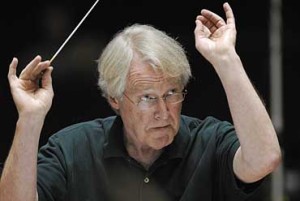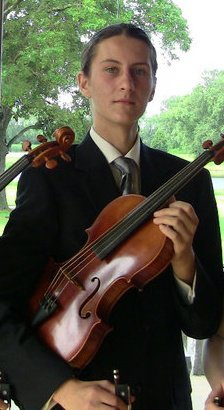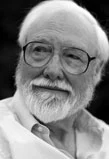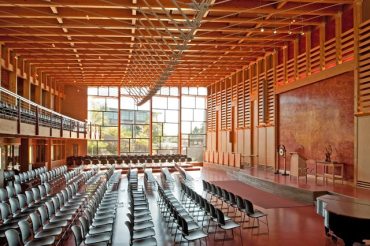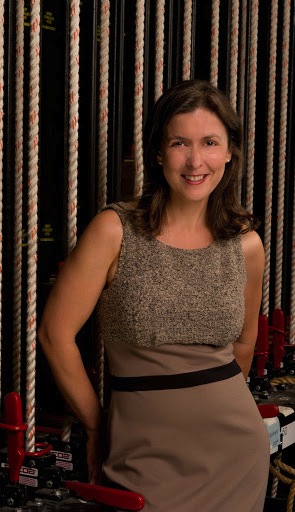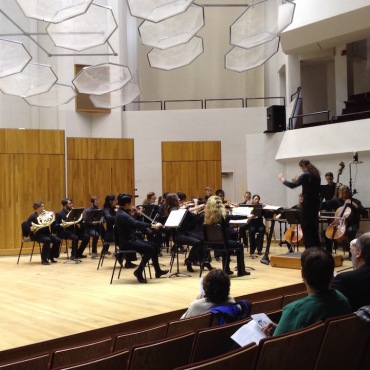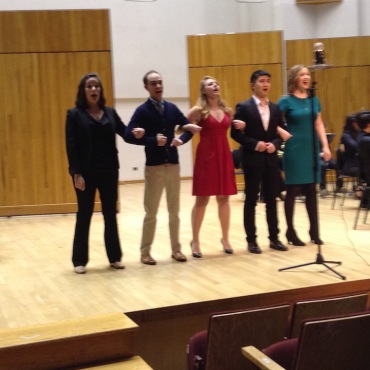The Well-Tempered Ear
Classical music: Both Sides Now – University of Wisconsin violist Mikko Utevsky sees Brahms’ glorious “German” Requiem as both a singer and an orchestra player.
2 Comments
By Jacob Stockinger
Today’s post is an essay by guest blogger Mikko Utevsky (below). A freshman at the University of Wisconsin-Madison in the School of Music, Utevsky may be familiar to you as a loyal reader and commenter on this blog; as the former East High School student who founded and conducts the Madison Area Youth Chamber Orchestra (MAYCO); and as a member of Wisconsin Youth Symphony Orchestras (WYSO) who, talented and articulate, also blogged last summer about WYSO’s tour to Prague, Budapest and Vienna.
Utevsky started off the first semester singing in the tenor section of the UW Choral Union, a campus and community choir. Then, when joint rehearsals with the UW Symphony Orchestra started, he moved into that as the assistant principal violist.
A loyal and discerning reader thought that this Tale of Two Requiems, or at least two views of the same requiem, would make for an interesting post. She was absolutely right, as you can read below.
Two performances of the “German” Requiem will be given, both in Mills Hall: next Friday night, Dec. 7, at 8 pm.; and next Sunday night, Dec. 9, at 7:30 p.m. Tickets are $15 for general admission; and $8 for seniors (60+) and $8 for all students, including uW students. Tickets are available at the Vilas Hall Box Office (also serving as the Wisconsin Union Theater Box Office during renovations to the theater) or by telephone (608 265-ARTS (265-2787) or at the door. For more information, visit: http://www.uniontheater.wisc.edu/boxoffice.html
By Mikko Utevsky
The “German” Requiem by Brahms is core masterwork in the choral-orchestral repertoire, albeit a slightly unusual one. It is not a traditional Latin Requiem — like last spring’s performance of the massive one by Verdi, with its earth-shaking “Dies Irae” — but rather one compiled from German (Lutheran) translations of sacred, non-liturgical texts.
It is primarily a humanist work, not a specifically Christian one: in fact, for its premiere, the conductor insisted on including an aria from Handel‘s “Messiah” referring to redemption through Christ, a concept Brahms deliberately omitted. God is instead depicted as a supreme teacher (in the third movement, “Herr, lehre doch mich”), comforter (in the fifth, “Ich will euch trösten”), or a pillar of strength (in the second – “Aber des Herrn Wort bleibet in Ewigkeit”). The terrible imagery of the Day of Wrath that features so prominently in most requiems is here replaced with a solemn majesty and a comforting gentleness.
The piece is set in seven movements, composed for chorus and symphony orchestra with soprano and baritone soloists. (The latter are, respectively, UW School of Music undergraduates Olivia Pogodzinsky and Benjamin Li, respectively.) The conductor is Beverly Taylor. (A photo of Benjamin Li, who competed and won in the Metropolitan Opera regional auditions, is below.)
Its craftsmanship is excellent. Ever the classicist, Brahms places large, demanding fugues at the climactic points of the third and sixth movements, setting the texts, “The souls of the righteous are in God’s hand” and “Lord, you are worth to receive glory and honor and power.”
The orchestration is lush and evocative, making extensive use of the brass in particular. The first movement uses no violins (making it an excellent excerpt in this violist’s estimation), and Brahms (below) commonly pares the horn quartet down to two for more intimate writing.
As alluded to above, I will be playing viola in the upcoming performance of this work — a position in the orchestra I tend to describe as the best seat in the house, right in the middle of the sound both physically and aurally. (In point of fact, choral sound tends to go over one’s head at the front of the strings, so the seats in the house really are better than mine for a work like this.)
However, I have had the fascinating experience of approaching this work from another side – that of the chorus.
I had never sung in a choir before this semester, but I decided to try out for the Choral Union for the experience of it, and to make sure I’d get a chance to learn the Brahms. (A UW Chamber Orchestra, below) also exists and I had not yet learned which orchestra I’d be playing in this semester.)
I learned a whole new way of approaching a work there — one grounded in the text, a more gradual (and perhaps more organic) process of assimilating the words and music than I was used to from the orchestral side.
When it came time to move from chorus to orchestra, I realized that I missed the physicality of singing, and the direct connection with the text: but knowing the landscape of the work and its texts gave me a valuable insight into the role of the orchestra.
In any work with chorus, the text (below is the manuscript to the opening of the seventh and final movement, “Selig sind die Toten” or “Blessed are the Dead”) is the greatest key to the affect of the music. Having an awareness of that facet of the piece makes the process of bringing the text to the fore easier and more rewarding. The rationale for a slight tenuto before “So seid nun geduldig” is perfectly clear if one knows that the passage translates to “So be patient,” and the bit of text-painting Brahms indulges in with the “morning rain and evening rain” in pizzicato strings and harp is that much more playful.
On the more concrete side, knowing when the viola doubles the tenors in the third movement’s massive fugue is an indispensable aid in determining balance, as is knowing where the orchestra gives the chorus its pitches. Since viola and tenor tend to overlap in register, particularly with Brahms’ high tenor writing, my place in both ensembles was particularly felicitous.
Each side has its advantages. Brahms’ writing for the viola (below) is excellent, and the instrument feels at home in the rich textures of his work. As assistant principal, there is a certain amount of leadership in the part as well, albeit more by example than in decision-making or addressing the section as is the principal’s role, and I think singing prepared me for that excellently, since I approached the part knowing that of the chorus already. By proportion, I think I am of more value to the 8-member viola section than to the tenor section of a 175-voice choir, too.
However, there is something vitally powerful about singing those fugues, or declaiming “Denn alles Fleisch es ist wie Gras” (Then all flesh is the grass”)… and “Aber des Herrn Wort bleibet in Ewigkeit” (But Still the Lord’s Word standeth”) together so many others, a strength and clarity of expression felt more directly with the text on one’s lips.
In general, regardless of ensemble, work, register, instrument or any other externalities, singing is a valuable (perhaps indispensable) experience for an instrumentalist.
Many things are obvious when sung that the technical considerations of an instrument make unclear. Questions of phrasing, tempo, articulation, and shape often resolve themselves if one simply puts down the instrument and listens. Particularly for string players, the physical considerations of the breath reveal much about how something ought to sound.
Many composers conceived of music vocally even when writing for instruments. Mozart wrote nearly everything as an opera, if one squints a bit when looking at it, and getting used to thinking in this way makes many things a great deal simpler.
The reverse is also true, though I think to a lesser extent. With text, particularly when it is spread between many long notes, it is easy to forget the musical line in favor of rendering each word as its own idea. Thinking instrumentally about such a phrase, as though one were governed by a bow that need never leave the string, helps minimize the disruption of breathing in the midst of a phrase too long to sustain on a single lungful, or keep continuity in staccato singing when it could easily become a series of disjointed syllables.
I feel more limited technically by the constraints of my developing voice than by my viola, but less as though I am struggling against the physical requirements of production to convey my musical intent.
The bow (below) betrays me far more than the breath, and I think the breath more commonly reveals the correct way to shape a phrase, when the bow might mislead. At the same time, breath limits the length of a phrase where bow changes can be disguised, and registral breaks in my young tenor voice are far more disruptive to the musical line than string changes or shifts.
Overall, though, I think the experience of singing as an instrumentalist has taught me more about the two disciplines’ similarities than their differences. (Below is a photo of Mikko Utevsky conducting the Madison Area Youth Chamber Orchestra.)
Regardless of whether one is in a choir or an orchestra, singing with piano or playing in a string quartet, the basic truths of music remain constant.
There is still sound and there is still silence, consonance and dissonance (usually), tone colors, phrase shapes, articulations, and an overarching structure to the piece.
Both are physical activities, guided by breath (even when it is not necessary for the function of the instrument), intended to communicate and to express.
I would sooner urge an instrumentalist to sing than a vocalist to learn an instrument, because there is nothing external required and therefore the self-awareness it fosters is correspondingly greater, but in both directions the exchange is a valuable one. (Below is a photo of the UW Choral Union and the UW Symphony Orchestra).
From both ends, “Ein Deutsches Requiem” is a titanic work, with gripping climaxes, moments of extreme delicacy and poignant expression, and hairpin turns between anguish and joy. It is tautly constructed and formally intricate, intellectually exciting without losing an ounce of expressive power.
I am grateful for having had the opportunity to experience it from two sides, and I think my understanding is richer for it.
Classical music education news: Wisconsin Youth Symphony Orchestra’s Youth Orchestra will tour in Europe from July 7 to July 17. A FREE preview concert is at Olbrich Gardens on Tuesday night and you can follow the tour with blogger Mikko Utevsky right here.
18 Comments
NEWS FLASH: Violist Mikko Utensky of Madison, who also founded and conducts the Madison Area Youth Chamber Orchestra (MAYCO), has agreed to blog about the WYSO tour to Europe — which he is going on — for The Well-Tempered Ear. Are we not lucky?
By Jacob Stockinger
July is a big month for the Wisconsin Youth Symphony Orchestras.
The young musicians of WYSO’s premier performing group, the Youth Orchestra (below), are preparing for a fantastic opportunity this July, when they will travel to Prague, Vienna and Budapest on WYSO’s first international tour since 2005.
Youth Orchestra members will have a chance to visit some of the most significant locations in the history of classical music and will perform in world-class venues.
The tour will be led by WYSO Music Director James Smith (below, in a photo by Jeff Miller for U-Madison), who has served as conductor of the Youth Orchestra for 27 years and who also serves as Director of Orchestras for UW-Madison’s School of Music.
In 2010, Smith was named Musician of the Year by The Well-Tempered Ear blog. Here is a link to that posting:
More recently, he was also profiled in the “Know Your Madisonian” feature in The Wisconsin State Journal. Here is a link to that story:
The 69 WYSO musicians who will attend the tour range in age from 14-18 years old and hail from 19 communities across southern Wisconsin.
The tour, which will run from July 7-17, will include concerts at Glasenersaal of the Musikverein in Vienna, the Czech Museum of Music in Prague (below), and the Military Museum in Budapest.
Repertoire for the tour will include Vaughan Williams’s “London” Symphony, “Le Roi d’Ys” Overture by Lalo, Slavonic Dance No. 8 by Dvorak, and The Courtly Dances from “Gloriana” by Britten.
Prior to their international tour performances, the Youth Orchestra members will give a bon voyage concert at Olbrich Botanical Gardens (below) on Tuesday, July 3, at 7 p.m. The concert is free and open to the public, with a $1 suggested admission donation to support the gardens. These young cutural ambassadors deserve a great send-off.
For more information about the tour and about WYSO in general, visit:
Leave the young musicians a farewell message in the COMMENTS section. The Ear will try to keep you current with the tour and the reception these young artists receive.
Classical music review: High school musician and critic Mikko Utevsky praises the new opera “Wired For Love” by UW student Jerry Hui.
6 Comments
ALERT: This week’s FREE Friday Noon Musicale, from 12:15 to 1 p.m. in the Landmark Auditorium (below) of the First Unitarian Society Meeting House, 900 University Bay Drive, features oboist Scott Ellington and pianist Ted Reinke, in music by Alex (Alec) Wilder, Gordon Jacob and Srul Irving Glick. For information, call 608 233-9774 or visit www.fusmadison.org.
By Jacob Stockinger
Earlier this week, I posted a a review of the world premiere of UW student Jerry Hui’s chamber opera “Wired For Live” by guest reviewer by John W. Barker, who normally reviews for Isthmus and who is veteran music critic as well as a distinguished retired UW-Madison history professor.
(By the way, “Wired For Love” has been recorded and there will be CDs available of it in the near future. I’ll pass along word when I get it.)
Here, for purposes on comparison is a link to that first review:
But I also heard from a loyal blog reader and a multi-talented young musician in Madison, Mikko Utevsky.
Mikko (below) is a senior at Madison East High School and a part-time music student at the UW-Madison. He also plays the viola in WYSO (Wisconsin Youth Symphony Orchestra) and the UW Symphony Orchestra and conducts the Madison Area Youth Chamber Orchestra (MAYCO). He has done a Q&A for this blog (link is below) and offered comments on other postings. But this is his first major review and I am pleased to offer a forum to such a discerning young musician. It is vital that we in classical music cultivate and encourage young talent.
By Mikko Utevsky
I was very impressed Jerry Hui’s new opera “Wired For Love.” I’ve known Jerry (below) for four or five years, but I’ve never heard much of his music before. It was well worth braving the cold on Friday night, though it is too bad it competed with the Madison Symphony Orchestra concert.
To speak of the opera itself, the synopsis helps a great deal with piecing the story together. The narration can become a tad fragmented, but having read the original emails that’s not terribly surprising.
The set was spare and showcased the action nicely, I thought, although it did bother me when the singers weren’t quite placed opposite each other on a stage so strikingly symmetrical.
The singing was good, particularly from tenor Daniel O’Dea (below right) as Bako Ndiovu. I’m no judge of vocal technique, but with the exception of a few diction issues in the very beginning, a few consonants missing from the rather demanding high writing for Ethel Wormvarnish (played beautifully by Jennifer Sams, below left) whose arresting voice and expressive physicality perfectly matched the role), and a few little discrepancies between the words and the supertitles (which often lagged behind the singers), I thought the vocalists carried their roles very well and brought the story across with wit and intelligence.
Peter Gruett’s countertenor was surprisingly nuanced (Gruett is below on the far right), despite the inherently comic feel of the register and writing. And while the voice of James Held (below, far left) felt a tad thin at one or two moments, I thought it more a character trait than a technical flaw — it made sense in context. The humorous cracks in “I have a cold” were carried off very well, and made it one of my favorites.
The cast’s unique voices all stood out well in ensemble numbers, so you could catch all the jokes – and there were quite a few (both textual and musical).
It’s certainly a funny opera; the painstaking transcription of the scammer’s poor English is hilarious, as are Ethel’s antics. The opening of the opera feels a little awkward (although the overture is seriously fun), but it soon finds its groove.
Only once did the transitions feel jarring – moving between the sweet “Please Call Me” and Ethel’s vicious aria “Serpent! Viper!” was a tad awkward, and one short passage in the latter (and a few others in other places) might benefit from a slight enlargement of the string sections.
By and large, I liked the soloistic sound, but sometimes the string lines weren’t quite prominent enough (or needed the mass of a section for confidence’s sake; which was generally not a problem regardless).
That aside, the orchestra (below) danced and sparkled through Jerry’s vivacious score, lingering sweetly where needed. Ching-Chun Lai did a marvelous job bringing out the colors of the nine-player ensemble. Bako’s aria “Where the rivers meet” was beautifully tender, showcasing both Jerry’s writing for voice and orchestra and O’Dea’s sweet tenor well.
The final number (“The Moral Lesson”) was my favorite musical joke of the opera, a Renaissance dance with all the wrong counterpoint. That is a nod to Jerry’s work in early music, certainly, and one that drew a few laughs from the audience, which was curiously subdued until Ethel’s first aria, at which point we finally started applauding. The music earlier certainly deserved more than it got, but we were cold.
Perhaps Saturday’s performance will draw a larger crowd once the streets are plowed. Jerry’s work deserves it.
(Editor’s Addendum: Jerry Hui will teach a Continuing Education class on singing Gregorian Chant at the UW. The class meets every Saturday from 2 to 3:30 p.m., and will begin next Saturday, Feb. 4. Registration is required and can be done online through the website of the UW-Madison Division of Continuing Studies: http://www.dcs.wisc.edu/classes/music.htm)
Classical music Q&A: High school conductor Mikko Utevsky discusses the Madison Area Youth Chamber Orchestra, which makes its debut this Friday night in Vivaldi, Beethoven and Borodin
5 Comments
By Jacob Stockinger
The Madison Area Youth Chamber Orchestra (MAYCO) will present its premier concert on Friday, June 17, 2011 at 7:00 PM in Mills Hall in the UW-Madison Humanities Building, 455 North Park Street, in Madison.
The program, led by Madison East High senior, Mikko Utevsky, will consist of Alexander Borodin’s Overture to “Prince Igor”; Vivaldi’s “Summer” concerto from “The Four Seasons,” featuring Madison Symphony Orchestra co-concertmaster Suzanne Beia (below); and Beethoven’s Fifth Symphony.
Admission is $5 for adults; students are free. Donations will be accepted.
Mikko Utevski (below, in a photo by Steve Rankin who took all the photos here except for that of Suzanne Beia) recently spoke via e-mail about the concert, the orchestra members and himself:
What can you tell us about yourself and the orchestra?
I’m a violist who just completed his junior year at at East High School. I’ve played for eight years or so and I’ve been in the Wisconsin Youth Symphony Orchestras for five years. I studied composition for a number of years and moved from there to conducting.
I’ve studied to varying degrees with my school orchestra director, Jackie Dhoore-Becker whose husband David Becker directs the orchestras at Lawrence University in Appleton; with Matthew Schlomer, the Graduate Assistant Conductor of the UW Band; and with Thomas Buchhauser, whom I played under in WYSO for a year.
The MAYCO orchestra is made up of high school and college students from all around the Madison area. I met most through WYSO (below), though many heard about the program through others.
How many members are there are what are their ages?
We have about 50 players, ranging throughout high school with a few college students. There is one adult, an old friend, playing continuo for the Vivaldi.
Do you all come from East High School?
Not at all. I believe there are two other East students in the orchestra; most are from other high schools throughout the city and surrounding area.
How did the orchestra get started and why?
I got into conducting through score study. I studied composition for about three years before realizing I preferred studying scores to writing my own. I started realizing that if I wanted to conduct, I needed an ensemble, because there’s only so much you can practice in front of a mirror. I’d never seriously thought about starting one until last June.
Last summer, I played in the Wisconsin State Honors Orchestra. I met a student there named Isaac Young, from Waukesha, who has been running a similar program there for four years now (the Waukesha Area Chamber Orchestra, or WACO). He convinced me that it was possible, and I spent the rest of the summer planning a program and recruiting musicians.
The model is based on the Honors program and UW Music Clinic, or any summer festival, really. We have a brief, intensive rehearsal period, followed by a concert.
I think there’s a place for a program like this here, not because we’re strapped for choices in classical music but because it’s totally student-run. It’s not so much a camp or a class as it is a group of people getting together to teach each other. It’s a tremendous learning experience for me as a conductor, and I hope it is as valuable for every player as well.
How does it operate? Do you lead it and choose repertoire? Or is it more of a cooperative group?
As a student, I don’t have the clout of a professional teacher or conductor, nor do I have their experience. For some aspects of performance – bowings, for example (below) – I will try to work with the orchestra to find the best way to play a passage.
As to what “best” might mean for a particular piece or passage, that is unfortunately somewhat impractical to decide democratically in a 50-piece chamber orchestra.
That’s where my job starts, really. Here, as in any orchestra, the conductor must try to coax a unified vision of the piece out of players with differing backgrounds, opinions, and technical abilities.
Programming was unfortunately dictated by instrumentation, which has been pretty much constantly changing since the first day of recruiting, although I have tried to get as much input on that as I could.
Things like seating have been determined partially based on where musicians sit in WYSO (for those who are members) and partially on trying to extend opportunities to all players. Winds and brass rotate, for example, to allow multiple people to play principal.
What can you tell us about the works on the inaugural program, especially the Beethoven Symphony and why they were chosen?
The piece by Borodin (below) was both an easy choice and a hard one. I thought about a number of different overtures, and they were all wonderful pieces, but I just love the Russian style. “Prince Igor” is a bright, vivacious piece, full of verve and Russian soul. It also provides an excellent opportunity for the full brass section to have some fun, to give every player who signed up a chance to play. Fun doesn’t mean easy, though.
The violin concerto by Vivaldi makes for a very sharp contrast with the works on either side, but it gives us a chance to cultivate a more Baroque sound, lets the winds rest, and most importantly, allows us to bring in a fantastic soloist. I’ve studied with Suzanne Beia (below) for two years now as a chamber music coach, and she’s a brilliant musician and a wonderful person. I am really looking forward to working with her as a soloist.
Beethoven’s Fifth was part of my vision for this project when I first started planning it, and although I toyed with replacing it, some of the players talked me out of it.
It’s the classic warhorse of the repertoire — everyone has to play it at some point, and everyone knows it, which cuts down on the time needed to learn it. I love the piece, and I’m really looking forward to working on it this week.
Unfortunately, certain readings have become so popular that the way some passages are played has little resemblance to how Beethoven (below) wrote them. Take the opening, for example. It’s often played very slowly, and a bit like a triplet (with emphasis on the first note), with a big rest after the fermata. But that’s not what’s in the score. Those notes are upbeats to the fermata, and there’s only an eighth rest before the next “da-da-da-DUM” arrives.
What do future plans and concerts for the orchestra include?
Part of the nature of the program is that it’s only one-week long. Scheduling regular rehearsals over a longer period is simply impossible for an organization of this size and nature – during the year people are too busy, and in the summer people leave town.
I’d like to do this again next summer, and I’m hoping the musicians will enjoy it enough to return. Many of them are leaving for college this fall, so I may have to recruit from next year’s WYSO players once again, but I hope some will come back to Madison to play next year.
I will be a senior in the fall, but in the back of my mind I have this notion that I might continue organizing this in college for the next several years.
What do you and others think about the role of arts education and why it is important?
I started playing in school. If it weren’t for my music teacher at Marquette Elementary School, Jason Jacobs, I’d never have picked up the viola, and none of this would have happened.
The work school music teachers do is incredibly difficult, important, and under-appreciated. Not everyone can afford to study privately, and it’s school music curricula that make it an art anyone can pursue.
Organizations like WYSO (below) are equally important. I’d never have played in a symphony orchestra without WYSO, nor have gotten into chamber music at all. The opportunity to work with other dedicated students and with such phenomenal conductors is really extraordinary.
Is there more you would like to say about yourself or the group?
Personally, I want to major in music – get a bachelor’s degree in viola performance and a Master’s in conducting. Among the ensemble, we have a huge range of interests, from music majors to neuroscientists, engineers, librarians and doctors. I think they are all great musicians, and will certainly be great at whatever they choose to pursue after this. I do hope they come back next year, though.
Classical music: Here are the winners of last night’s Final Forte competition of the Madison Symphony Orchestra. Plus, the new student opera group at UW-Madison gets off to a promising start with an all-Mozart program. And the UW Choral Union changes its performance date of Haydn’s “The Creation.”
2 Comments
ALERT 1: Here are the results from last night of the Madison Symphony Orchestra‘s Final Forte competition of teenage concerto performers: The two Honorable Mentions go to pianists Liam Mayo and Audrianna Wu; the second prize goes to violinist Tabby Rhee; and the winner’s prize goes to marimbist Robert Rockman.
For more information about the competition, the contestants and the rebroadcasts on Wisconsin Public Radio and Wisconsin Public Television, visit:
ALERT 2: The UW-Madison Choral Union has moved its one-time only performance of the oratorio “The Creation” by Franz Joseph Haydn from Sunday, April 24, to 8 p.m. on the previous night, Saturday, April 23. At the same time, the separate concert by the UW Chamber Orchestra that was scheduled for Saturday, April 23, has been CANCELLED because it will instead accompany the Choral Union that same night.
By Jacob Stockinger
Here is a special posting, a review written by frequent guest critic and writer for this blog, John W. Barker. Barker (below) is an emeritus professor of Medieval history at the University of Wisconsin-Madison. He also is a well-known classical music critic who writes for Isthmus and the American Record Guide, and who for 12 years hosted an early music show every other Sunday morning on WORT FM 89.9 FM. He serves on the Board of Advisors for the Madison Early Music Festival and frequently gives pre-concert lectures in Madison.
By John W. Barker
The infinitely versatile and irrepressibly enterprising Mikko Rankin Utevsky (below) has come up with another project to pursue: the Impresario Student Opera.
Impresario Student Opera made its debut in Mills Hall last Sunday night.
The program was all-Mozart.
It began with an orchestral work, the Symphony No. 35, the “Haffner.” There was a 24-player orchestra, which did commendable work, though the strings were really rather thin. But Utevsky again proved himself a savvy conductor.
The rest was Mozart opera.
A recitative and duet from Act II of Così fan tutte, “Il coro vi dono,” has Guglielmo (Gavin Waid) scoring success in wooing his comrade’s sweetheart, Dorabella (Meghan Hilker). For these, co-director Dennis Gotkowski conducted. (You can hear the scene in a YouTube video at the bottom.)
After the intermission came the main event — appropriately, the eponymous comedy Der Schauspieldirektor (The Impresario). This was very freely adapted by turning the title character into a woman — by no means what Mozart expected.
Five singers (below top) were mustered: Waid and Hilker, with Anna Polum and Nicole Heinen as the dueling sopranos (below bottom), and Jiabao Zhang as the sugar daddy of one of them.
The dialogue was rewritten and given in English, the musical numbers sung in what purported to be German — but diction lessons are badly in order.
In their star roles, Polum was powerful, if a little unsteady at moments, while Heinen was a quite sprightly soubrette. Utevsky conducted, but had some parts in the comedy too. Stage director Alannah Spencer showed imagination in her staging.
There were a lot of in-group jokes, aimed at a rather rowdy claque of voice students.
All in all, though, despite a bumpy start, this project bodes well as expanded opportunity for the splendid vocal talent that the University of Wisconsin-Madison School of Music attracts.
Tags: Arts, chamber orchestra, choral music, Classical music, Concert, concerto, conductor, Cosi fan tutte, Early music, Final Forte, Haffner, Haydn, honorable mention, Jacob Stockinger, Madison, marimba, Mozart, Music, opera, oratorio, Orchestra, percussion, Piano, prize, soprano, strings, teenage, The Creation, United States, University of Wisconsin-Madison School of Music, University of Wisconsin–Madison, UW Choral Union, Violin, vocal music, wisconsin public radio, Wisconsin Public Television, Wolfgang Amadeus Mozart, YouTube











